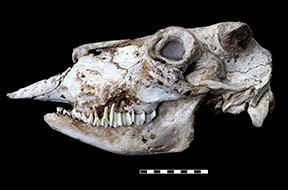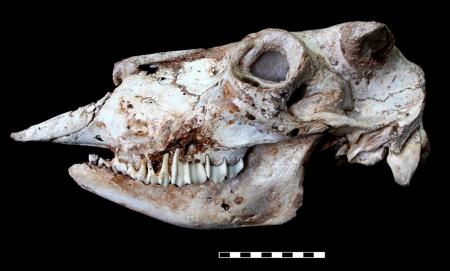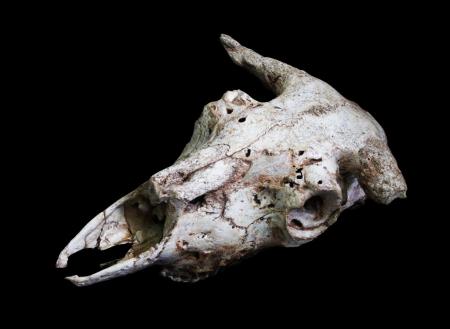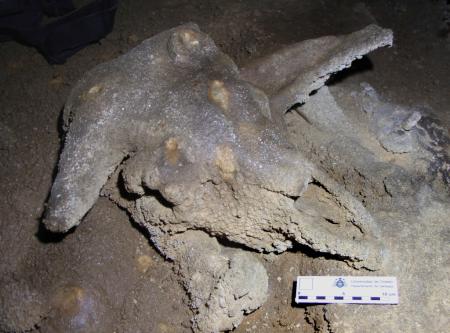Research staff from the University of Oviedo have discovered fossilised musk ox bones from the so-called 'mammoth fauna,' dating 35,000 years
A research team from the University of Oviedo has discovered fossilised musk ox bones, 35,000 years old, in a cave in Picos de Europa, documenting the presence of this animal, the so-called "mammoth fauna," on the Cantabrian Coast, for the first time. The cave where the remains were recovered is located near Tresviso, in Cantabria, one kilometre from the border with Asturias. Findings like this show that caves on the Cantabrian Coast still house an infinity of paleontological treasures that behold great surprise and force history to be rewritten about the animals that lived in this region during the last Ice Age.The results of the work, carried out by the GEOCANTABRICA Group, have been published in the prestigious "Quaternary Science Reviews" journal.
Researchers Montserrat Jiménez Sánchez, professor of External Geodynamics at the University of Oviedo; Diego J. Álvarez Laó, professor of Palaeontology at the University of Oviedo; Daniel Ballesteros, researcher at the University of Rouen-Normandie/CNRS, France; Florent Rivals, research professor at ICREA and the Rovira i Virgili University, Tarragona; Pablo Valenzuela, geologist from TRAGSATEC, León; and Adrián Álvarez Vena, predoctoral researcher in Palaeontology at the University of Oviedo participated in the study. Mario Menéndez Fernández, professor at UNED, Picos de Europa National Park Directorate, Technical Office and Park Warden's Office, as well as the Escar Speleological and Canyoning Society, the Diañu Burlón Speleology Group and the Tresviso Cave Project also collaborated.
The discovery of the remains presented here was documented in 1986 by two British speleological groups; the Lancaster University Speleological Society and the South Wales Caving Club, who were exploring caves in the Picos de Europa. The remains were originally attributed to a cow, which is why the cave was named Cueva de Cabeza de Vaca or Cowshead Cave. More than 30 years later, in 2018, an interdisciplinary team from the University of Oviedo recovered these remains within the framework of the project "Service for the recovery and study of mammal fossil remains located in caves in the Los Picos de Europa National Park, 2017-2018," signed between the Picos de Europa National Park and the University of Oviedo Foundation.
These fossils were studied in the University of Oviedo Palaeontology Area and turned out to be of two musk ox individuals: a young male of about 20 months old, which includes an almost complete skull, and another subadult individual about 3-4 years old. The skull is an exceptional piece, since Pleistocene musk ox skulls normally correspond to adult individuals and no young specimen of the characteristics of the one found in the Picos de Europa has been documented before. For this reason, in order to carry out an adequate comparative study of this skull, work was carried out with modern specimens, since the musk ox still survives in certain regions of the Arctic. The specialists went to the Natural History Museum in Copenhagen, which houses one of the largest collections of current musk ox skulls, from Greenland, with almost 300 specimens, which was of great value for the comparative study.
The results of the study revealed certain differences between the Picos de Europa specimen and its current Greenland counterparts: the Picos de Europa specimen turned out to be larger than its current equivalents and has unique characteristics in its morphology and teeth, which had never been described before. The cause of the death of these animals was most likely related to an accidental fall through a natural trap; a natural well that vertically communicated the cave with the outside. From the estimated age of the youngest musk ox, it could be deduced that this animal died in winter. The micro-wear study on its molars indicated that the animal fed mainly on the twigs and leaves of trees and shrubs, probably willow and birch, at the time it died, which is also compatible with a winter diet.
During the Upper Pleistocene glaciations, musk ox roamed over wide regions of Eurasia and North America. On the Iberian Peninsula, its presence had only been detected in two sites in Girona. The Picos de Europa finding is therefore the first evidence of the presence of this species on the Cantabrian coast, which defines a new southwestern limit on the Eurasian distribution of this species and forces its distribution map during the Pleistocene to be redrawn.
In the last Ice Age, the presence of other typical cold climate animals such as woolly mammoths, reindeer and woolly rhinoceros, is documented in the north of the Iberian Peninsula. Other large herbivores such as steppe bison, giant deer and horses; as well as carnivores such as cave lions, leopards and hyenas, lived at that time on the Cantabrian coast in a landscape known as "tundra/steppe", where herbaceous vegetation was dominant and trees and shrubs were scarce. At this time, the glaciers still occupied the high elevations of the Cantabrian Mountains.
The fossil remains have been sent to the Museum of Prehistory and Archaeology of Cantabria, in Santander, where the skull is currently on display to the public.







